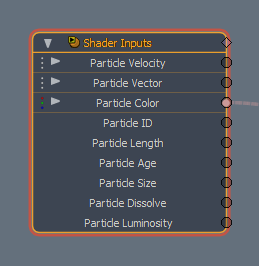
The Shader Inputs make accessible the internal sample vector used for rendering. This information is essentially the data that is used to describe any given shading sample. This provides access to computed values at the Shader level, on a per sample basis.
The Shader Input node is added to the Schematic viewport using the Add function, found in the pop-up menu under Shader Inputs > Shader Inputs. The Shader Inputs node is unique, in that it comes in without any specific channel associations. This is because there are many channels that can be used by the node, and having them all present at once would be overwhelming. Evaluation channels can be added as packages on an as-needed basis. This is done by right-clicking on the resulting node in the schematic and choosing the appropriate option from the Add Shader Input menu option. This can also be used to add additional Shading Input packages to existing Shader Input nodes.
For ease of use, it is also possible to add a Shading Input and channel packages in one step, using the additional options found in the Schematic viewports Add Menu. In the Shader Inputs sub-menu, there are options for each Package type available: Particle Sample, Sample Position, Sample Ray, Surface Normal, and Texture Ray.
There are no specific inputs for the node, but each sample type is evaluated automatically for every position and returned to its specific output.
NOTE: For information on working with node graphs, see Schematic Viewport

Particle Samples
|
Option |
Description |
|---|---|
|
Particle Velocity Output |
Outputs the computed Particle Velocity values. |
|
Particle Vector Output |
Outputs the computed Particle Vector values. |
|
Particle Color Output |
Outputs the computed Particle Color values. |
|
Particle ID Output |
Outputs the computed Particle ID value. |
|
Particle Length Output |
Outputs the computed length of the particles. |
|
Particle Age Output |
Outputs the computed age of the particles since birth. |
|
Particle Size Output |
Outputs the computed size of the particles. |
|
Particle Dissolve Output |
Outputs the computed transparency of the particles. |
|
Particle Luminosity Output |
Outputs the computed luminosity of the particles. |
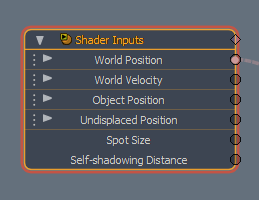
Sample Position
|
Option |
Description |
|---|---|
|
World Position Output |
Outputs the computed Position of a given sample in world space coordinates. |
|
World Velocity Output |
Outputs the computed world velocity of a given sample. |
|
Object Position Output |
Outputs the Position of a given sample in Object Space coordinates. |
|
Undisplaced Position Output |
Outputs the undisplaced Position of a given sample on a geometric surface in Object Space coordinates. |
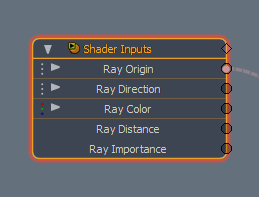
Sample Ray
|
Option |
Description |
|---|---|
|
Ray Origin Output |
Outputs the computed sample Ray Origin position for a given sample. |
|
Ray Direction Output |
Outputs the computed sample Ray Direction for a given sample. |
|
Ray Color Output |
Outputs the computed Ray Color for a given sample. |
|
Ray Distance Output |
Outputs the computed ray length for a given sample. |
|
Ray Importance Output |
Outputs the Rays computed Importance value for a given sample. |
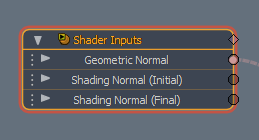
Surface Normal
|
Option |
Description |
|---|---|
|
Geometric Normal Output |
Outputs the geometric normal of a given sample. |
|
Shading Normal (Initial) Output |
Outputs the unperturbed normal of a given sample. |
|
Shading Normal (Final) Output |
Outputs the perturbed normal of a given sample. |
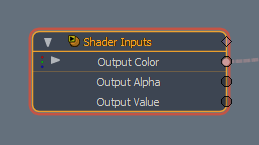
Texture Value
|
Option |
Description |
|---|---|
|
Output Color Output |
Outputs the computed color of a given sample. |
|
Output Alpha Output |
Outputs the computed texture transparency of a given sample. |
|
Output Value Output |
Outputs the computed texture value of a given sample. |